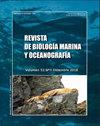Reproductive aspects of Chiton virgulatus in Bahía de La Paz, Gulf of California, Mexico
IF 0.5
4区 生物学
Q4 MARINE & FRESHWATER BIOLOGY
引用次数: 0
Abstract
This study analyzed the reproductive cycle of Chiton virgulatus and its relationship with air temperature (AT) sea and surface temperature (SST), photoperiod, and tidal cycle (TC) in Bahia de La Paz, in the coast of the Gulf of California. Monthly samples were collected from September 2008 to September 2009. The parameters recorded included total length, total weight, and gonad weight of each organism; the gonad was processed using a histological technique, and the gonadal index and length at first maturity (L50) were estimated. C. virgulatus displays partial spawning with a reproductive peak in summer and autumn (July to December). The frequency of ripe organisms was associated with rises in SST (30.6 oC), AT (29.9 oC), and TC (68 cm, high tidal), while photoperiod (longer days) regulated the frequency of developing organisms. The length at first maturity was 29.7 mm. Chiton virgulatus is a polyplacophoran species in which high temperatures and high tides influence reproductive timing, while an increase in daylight boosts gonad development.墨西哥加利福尼亚湾Bahía de La Paz奇特石鳖的繁殖特征
本研究分析了加利福尼亚湾沿岸巴伊亚德拉巴斯(Bahia de La Paz)奇特鱼(Chiton virgulatus)的繁殖周期及其与气温(AT)、海温和地温(SST)、光周期和潮汐周期(TC)的关系。2008年9月至2009年9月每月采集样本。记录各生物的总长度、总重量、性腺重量等参数;用组织学技术处理性腺,估计性腺指数和初成熟长度(L50)。黄颡鱼部分产卵,夏秋两季(7 ~ 12月)为繁殖高峰。成熟生物的频率与海温(30.6 oC)、温度(29.9 oC)和温度(68 cm,高潮)的升高有关,而光周期(较长的日照)调节发育生物的频率。初熟时长度为29.7 mm。virgulatus是一种多placophoran物种,高温和涨潮影响生殖时间,而日光的增加促进性腺的发育。
本文章由计算机程序翻译,如有差异,请以英文原文为准。
求助全文
约1分钟内获得全文
求助全文
来源期刊
CiteScore
0.70
自引率
0.00%
发文量
41
审稿时长
12 months
期刊介绍:
Publicar desde una perspectiva científica, artículos originales, decididos por un proceso de revisión por pares, invitando a expertos de reconocido prestigio en el área. Los trabajos publicados se caracterizarán por su solidez teórica-metodológica, actualidad y relevancia para las ciencias marinas.
Se reciben trabajos inéditos derivados de la investigación científica realizada en ambientes marinos y estuarios, en formato de Revisión, Artículos, Notas Científicas, y Obituarios en las siguientes disciplinas::
Biología-Ecología marina
Oceanografía física, química y biológica
Contaminación marina
Geología marina
Sistemática, Faunística y Biogeografía Marina
Manejo Costero
Acuicultura marina
Pesquería marina.

 求助内容:
求助内容: 应助结果提醒方式:
应助结果提醒方式:


